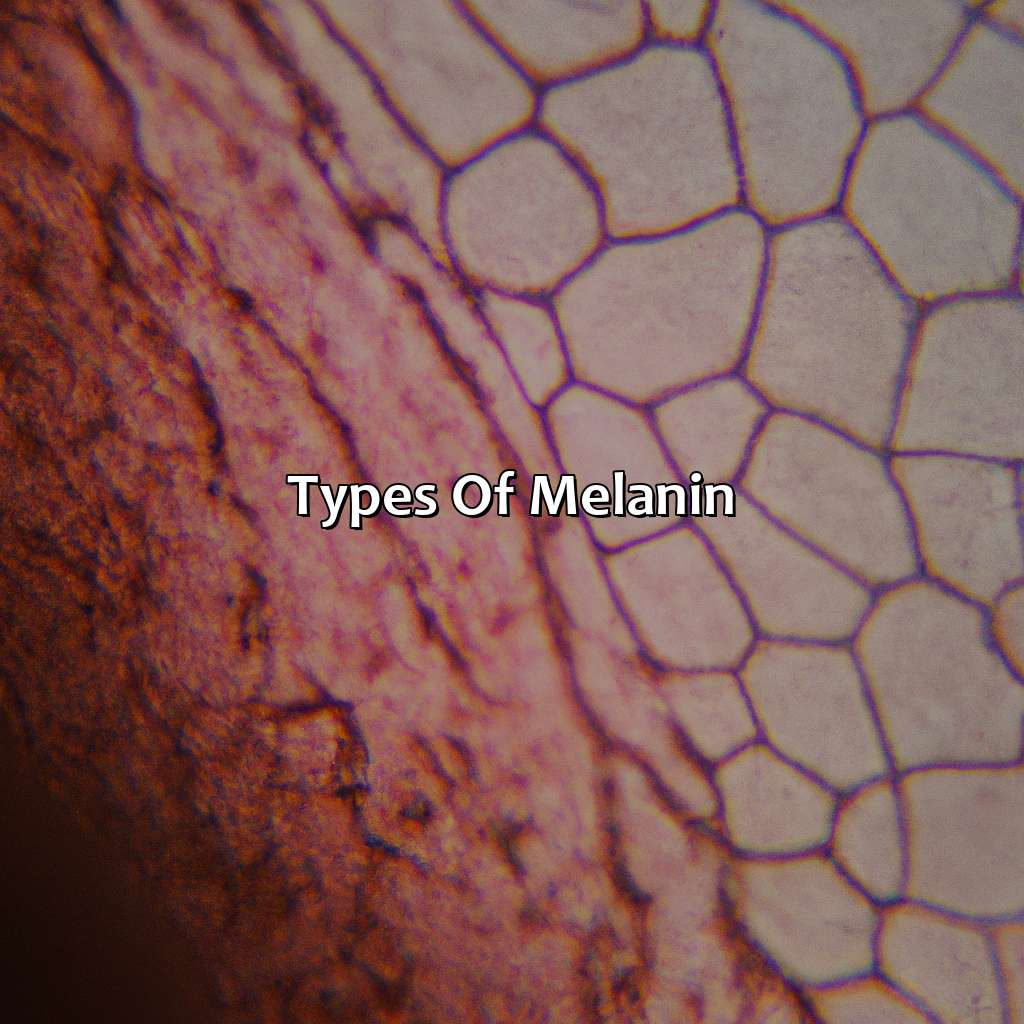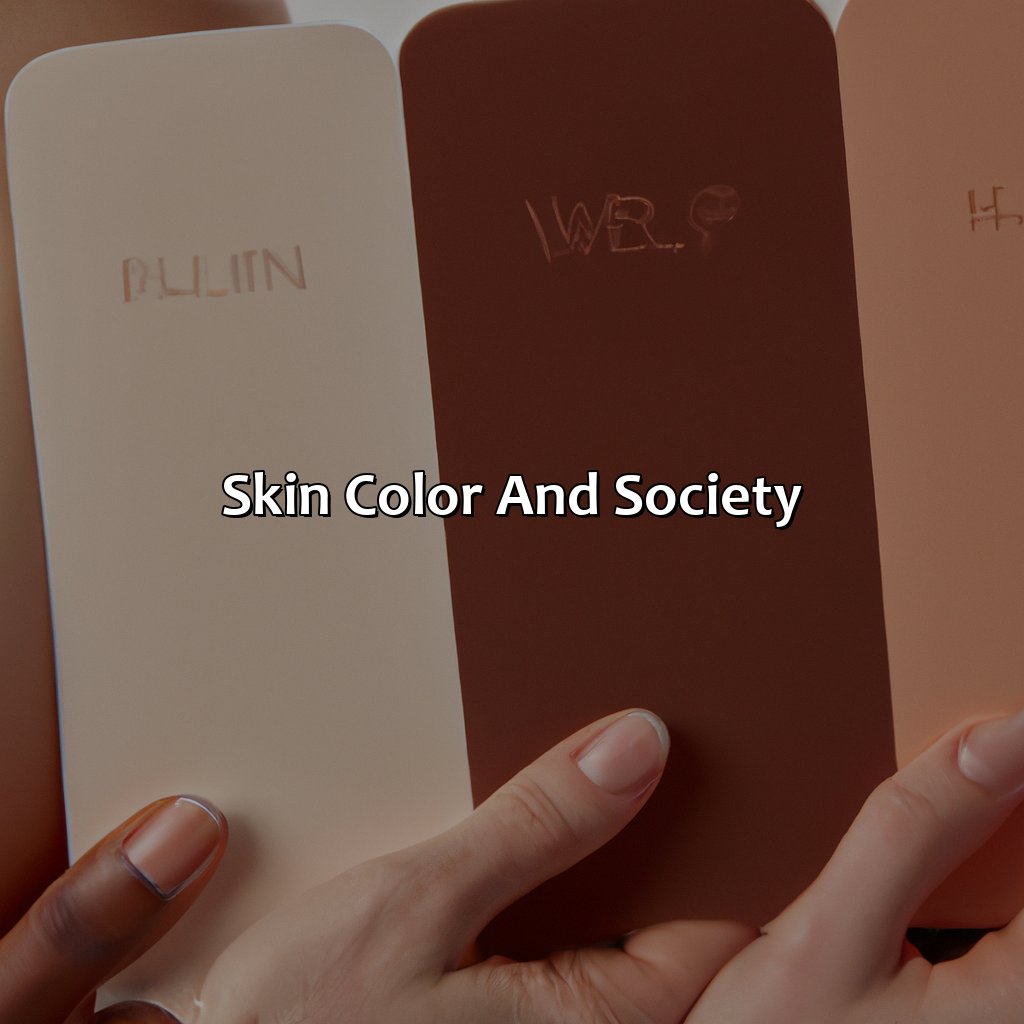Key Takeaway:
- Genetics play a significant role in determining skin color, with specific genes influencing the production and distribution of melanin in the skin.
- Environmental factors such as UV radiation from sun exposure can also affect skin color and increase the risk of skin cancer, but proper protection can reduce these effects.
- Cultural and societal constructs around skin color have had a significant impact on history and continue to impact the way people perceive and treat others based on their skin color, leading to discrimination and stigma.
Understanding Melanin Production

Photo Credits: colorscombo.com by Gary Nelson
To understand skin color, look into the role of melanocytes. These cells produce melanin, which gives color to the skin. Genetics are key as they decide how much and what type of melanin is produced. UV radiation, like sun exposure, can influence skin color and increase the risk of cancer.
Role of Melanocytes
Melanocytes play a crucial role in the production of melanin, which is responsible for determining the color of our skin. These specialized cells are found in the outer layer of the skin and are involved in producing, storing, and distributing melanin to surrounding skin cells.
Melanocytes are activated by various factors such as UV radiation and hormonal changes, but their activity is mainly regulated by genetic factors.
Melanocytes produce two types of melanin – eumelanin and pheomelanin. Eumelanin is responsible for darker skin tones while pheomelanin contributes to lighter skin tones. Neuromelanin is another form of melanin that is found in the brain and nervous system. The type and amount of melanin produced by melanocytes are largely influenced by genetics.
While genetics plays a dominant role in determining skin color, external factors such as UV radiation can also impact melanocyte activity. Increased exposure to UV radiation leads to an increase in melanocyte activity and subsequently a change in skin color.
Skin color has several implications on health, including vitamin D synthesis and susceptibility to skin cancer. Darker-skinned individuals require longer exposure to sunlight to produce adequate amounts of vitamin D, while lighter-skinned individuals may be at higher risk for developing skin cancer due to increased susceptibility to UV radiation.
There have been significant historical and cultural influences that have shaped societal attitudes towards different skin tones. Society has constructed stigmas regarding certain skin colors which have impacted individuals’ self-perception.
Genetics is like playing a game of skin color roulette, where hereditary factors, gene expression, and mutations all determine the outcome.
Influence of Genetics
Genetics play a significant role in determining skin color as it is hereditary. Gene expression and mutations in genes that code for melanin production can lead to variations in skin tone. The type and amount of melanin produced by the body are determined by genetics, with some individuals having more eumelanin than pheomelanin or vice versa.
Variations in genes such as SLC24A5, SLC45A2, TYR, and OCA2 have been associated with differences in skin pigmentation. Mutations in these genes can result in hypopigmentation or hyperpigmentation, causing albinism or darker skin tones.
It’s important to note that while genetics play a significant role, environmental factors such as UV radiation can also influence skin color by stimulating melanocyte production. Therefore, individuals with similar genetic backgrounds may still have different skin tones due to variations in environmental exposure.
To better understand and address disparities related to skin color, further research should be conducted on both genetic and environmental factors that impact pigmentation. Additionally, encouraging society to value diversity and embrace all shades of skin can help reduce social stigmas surrounding race and ethnicity.
Just like a vampire, too much sun exposure can turn your skin into a deadly shade of red.
Effects of UV Radiation
Excessive exposure to solar radiation can have catastrophic effects on the human skin, leading to damage and potential health risks. The impact of UV radiation from the sun can be especially significant as it penetrates deeply into the skin, causing damage to DNA and triggering harmful mutations. Prolonged exposure to UV rays may cause premature aging, sunburn, and even skin cancer.
Thus, Sun exposure is an essential aspect when discussing skin color and health. Regular or prolonged exposure to UV radiation can lead to increased risk of developing skin cancer, such as melanoma. Excessive exposure or lack of proper protection against UV radiation can lead to prominent photodamage signs like fine lines, wrinkles, hyperpigmentation (dark spots), and dullness of the skin.
It is imperative to know that factors like ethnicity play a substantial role in determining the level of melanin our body produces in response to sun exposure. Individuals with lighter skin colors tend always to be more prone to sunburns as their bodies do not possess much melanin content; therefore, individuals with fairer complexion must always use sunscreen protection for effective safeguarding against UV rays.
To avoid bearing a higher risk of suffering from adverse side effects like skin cancer due to excessive UV Radiation exposure from sunlight, every person needs adequate knowledge in understanding how different external factors impact each unique’s different ethnic background’s nature while working towards adopting healthy practices that guarantee long-term benefits to avert dangerous outcomes.
From jet black eumelanin to fiery pheomelanin and mysterious neuromelanin, the world of melanin is full of colorful surprises.
Types of Melanin

Photo Credits: colorscombo.com by Brian Green
Types of Melanin
Melanin, a pigment produced by melanocytes, determines skin color. It exists in three forms: eumelanin, pheomelanin, and neuromelanin. Eumelanin and pheomelanin are responsible for the skin’s color variation, while neuromelanin is found in the brain and nervous system.
| Type | Color |
| Eumelanin | Brown to black |
| Pheomelanin | Red to yellow |
Eumelanin protects the skin from harmful UV radiation, while pheomelanin makes the skin susceptible to damage, leading to sunburn and skin cancer. Neuromelanin, on the other hand, helps protect the brain from oxidative stress and damage.
Pro Tip: Adequate sun protection can prevent skin damage and cancer, regardless of skin type or color.
Factors Affecting Skin Color

Photo Credits: colorscombo.com by Donald Carter
To comprehend the intricacy of skin color, it is essential to recognize the factors that affect it. Let’s delve into these factors, which include age, gender, and ethnicity. Examining age, gender, and ethnicity sub-sections will give you insight into how each factor impacts skin color, pigmentation, and racial disparities.
Age
As one ages, the production and distribution of melanin in the skin lessen, resulting in a gradual loss of pigmentation. The skin may also become thinner and drier with age, making it more prone to damage from external factors like UV radiation. Factors like hormonal changes and certain medications can also impact skin color with increasing age.
With advancing years, alterations in the structure and function of underlying tissues influence skin pigmentation levels leading to visible signs of aging such as uneven skin tone or hyperpigmentation. A decline in collagen production leads to sagging and wrinkling of the skin, which further alters the appearance and tone.
It is important to note that despite variations due to biology, ethnicity, and environmental factors; skin color continues to alter with age. In general, however, elderly people tend to have lighter skin than younger people.
Studies have indicated that with aging comes decreased melanocyte activity; this results in a decrease both in the intensity of existing melanin pigment (melanin content per keratinocyte) as well as a reduction in overall numbers of melanocytes within the skin. [source: Ostrom 1992]
Age-related changes that occur alongside skin color changes include an increased risk for eczema, infection and development of macular degeneration; photoprotection should be strongly encouraged among older adults for prevention of long-term effects on health.
Why be black or white when you can be a beautiful shade of beige? Except if you’re a man, then apparently you have to be tough and tan.
Gender
Skin color is influenced by various factors, one of which includes gender. Typically, women tend to have lighter skin than men due to hormonal differences that affect melanin production. Estrogen can cause the skin to produce more eumelanin, which is responsible for darker skin tones, while testosterone can lead to the production of less melanin and lighter skin tones.
However, individual variations influenced by genetics and ethnic background also play a crucial role in determining skin color. Though gender is a general factor that may influence the overall range of skin colors observed among different populations or ethnic groups, it cannot be viewed as an isolated or definitive factor.
Unique details such as cultural attitudes towards specific skin colors may also exist when considering the intersectional relationship between race, ethnicity, and gender. For example, women from certain cultures may view light-colored skin as being more desirable and attractive.
To foster healthy attitudes towards different skin tones and reduce harmful social constructs surrounding them, education on the biology of melanin production should be provided at an early age. This would help promote a deeper understanding and appreciation of how various factors converge to determine one’s unique appearance. Skin color may vary based on ethnicity, but we all have one thing in common: the ability to get sunburnt.
Ethnicity
Ethno-racial Diversity
Ethnicity plays an important role in determining skin color and pigmentation, which can affect one’s physical appearance and overall health. The variations in skin pigmentation among ethnic groups are due to differences in melanin production, influenced by genetics and environmental factors such as UV radiation exposure.
In the table below, we can see the different levels of melanin production across various ethnicities based on scientific research.
| Ethnicity | Melanin Production Level |
|---|---|
| African | High |
| Hispanic/Latino | Moderate to High |
| Mediterranean | Moderate |
| Asian | Low to Moderate |
| Caucasian/European | Low |
Although ethnicity is a significant factor, individual differences also exist within each category.
For example, African-Americans may have different amounts of eumelanin than Africans, due to intermarriage with other ethnicities over time. Additionally, race-based categories are socially constructed and can lead to harmful stigmas surrounding certain groups.
It is important for individuals to understand their natural skin color and how it affects their health. Failure to do so may result in a higher risk of skin cancer or vitamin D deficiency. Consultation with a dermatologist can help determine appropriate levels of sun exposure based on one’s unique skin type.
Do not let your fear of missing out on societal beauty standards push you towards potentially harmful practices such as tanning or lightening your skin color. Instead, embrace your natural ethno-racial diversity and take proper care of yourself accordingly.
Healthy skin color isn’t just a matter of looks – it also affects your vitamin D levels and skin cancer risk.
Skin Color and Health

Photo Credits: colorscombo.com by Robert Scott
To comprehend how skin color influences your health, delve into the part on Skin Color and Health. Focus on Vitamin D synthesis and Skin Cancer risk. These two subsections will assist you in exploring the connection between skin color and the synthesis of Vitamin D. Plus, it will show you the varying levels of skin cancer risk based on skin color.
Vitamin D Synthesis
Skin color plays a vital role in the natural synthesis of Vitamin D, a crucial nutrient that helps build and maintain bone health. This synthesis begins when skin cells exposed to ultraviolet B radiation from sunlight convert 7-dehydrocholesterol into pre-vitamin D3.
The liver and kidneys then convert this precursor into vitamin D, which regulates calcium absorption in the body.
A deficiency in vitamin D can lead to various health problems, including rickets in children and osteomalacia in adults. Due to their darker complexion, individuals with higher levels of melanin production may require more prolonged sun exposure or dietary supplementation for healthy vitamin D levels.
Genetic factors influencing skin color also play a role in differences among ethnic groups’ Vitamin D synthesis. Studies show that people with fairer skin are better equipped to produce this vital nutrient compared to those with darker complexions due to varying melanin concentrations.
For instance, scientists found out that African Americans living at northern latitudes are deficient in vitamin D compared to other groups, likely due to their greater potential for pigment production and therefore less effective sun-induced synthesis.
Skin cancer doesn’t discriminate based on skin color, so don’t let your beautiful melanin fool you.
Skin Cancer risk
Exposure to UV radiation greatly increases the risk of skin cancer, which is influenced by an individual’s skin color. Lighter-skinned people are at a higher risk due to their lack of melanin protection from UV radiation. Darker skin tones have more natural protection, but can still develop skin cancer if exposed to excessive amounts of UV radiation. It is important for individuals of all skin colors to protect themselves from the harmful effects of the sun by wearing proper clothing and sunscreen.
Skin cancer risks vary depending on an individual’s amount of melanin in their skin. Those with lighter skin tones have less natural protection from UV radiation, which increases their risk of developing skin cancer. Conversely, individuals with darker skin tones have more natural protection, but can still be at risk if exposed to excessive amounts of UV radiation.
It’s important to note that although darker-skinned individuals have a lower risk, they are not immune to developing skin cancer and should still take necessary preventative measures.
Pro Tip: Regular visits to a dermatologist can help detect early signs of skin cancer and prevent it from spreading.
Skin color has been so historically and culturally significant that society has constructed its own harmful stigma around it.
Skin Color and Society

Photo Credits: colorscombo.com by Juan Anderson
To grasp the effect of skin color on society, check out the area on skin tone and society. Focus on the historical and cultural impacts and the social constructs and stigma. Investigate how history, culture and ethnicity affect skin color. Examine how social constructs, discrimination and diversity shape our attitudes and behavior towards those with diverse skin tones.
Historical and Cultural Influences
Skin color is heavily influenced by historical and cultural factors, which have played a significant role in shaping our attitudes towards it. Throughout history, certain cultures have associated lighter or darker skin with specific social and economic status. For example, in ancient Rome, pale skin was considered fashionable among the upper class, while in some African cultures, darker skin was associated with beauty and wealth.
Furthermore, the concept of ethnicity has also influenced how we perceive skin color. Ethnic groups often share similar physical traits such as skin tone, facial features and hair texture that differ from other ethnic groups. As such, race has historically been a way to categorize people based on their physical appearance.
In some cultures, certain practices like sun tanning or bleaching have been used to alter skin color. This can represent a desire to conform to societal standards of beauty or to distance oneself from one’s ethnic heritage.
A particularly tragic aspect of the influence of culture on skin color is the stigmatization of people with darker complexions. In many societies, darker-skinned individuals are subject to prejudice and discrimination due to negative stereotypes perpetuated by cultural norms.
Unfortunately, society has constructed a stigma around skin color, leading to discrimination and a lack of tolerance for diversity.
Social Constructs and Stigma
Historically, European colonialism imposed ideas of white superiority, perpetuating negative stereotypes about other races. In turn, this has led to stigmatization, prejudice, and discrimination towards individuals with darker skin tones.
Today, there is a growing awareness of social constructs and stigma surrounding skin color. This recognition has led to movements promoting diversity and tolerance in societies worldwide. Governments have also introduced policies aimed at ending discrimination, such as affirmative action initiatives in employment and education.
However, the fear of missing out on opportunities still lingers for those who are marginalized due to their skin color. It is important for society to recognize that everyone deserves equal treatment regardless of race or ethnicity. Only then can we progress towards true acceptance and respect for all individuals irrespective of their skin color or heritage.
Five Facts About What Determines Skin Color:
- ✅ Skin color is determined by the amount and type of melanin in the skin. (Source: American Academy of Dermatology)
- ✅ Melanin is produced by specialized skin cells called melanocytes. (Source: National Human Genome Research Institute)
- ✅ Genetic factors play a significant role in determining skin color. (Source: Nature)
- ✅ Exposure to ultraviolet (UV) radiation from the sun or tanning beds can increase melanin production and darken the skin. (Source: Skin Cancer Foundation)
- ✅ Skin color differs among populations and can vary within individuals over time due to factors such as aging, hormonal changes, and exposure to environmental toxins. (Source: Scientific American)
FAQs about What Determines Skin Color
What determines skin color?
Skin color is determined by the amount and type of pigment melanin present in the skin. Melanin is produced by melanocytes, which are present in the epidermis of the skin. The more melanin in the skin, the darker the skin color.
What factors influence the amount of melanin in the skin?
A person’s genetic makeup, as well as their exposure to sunlight, are the primary factors influencing the amount of melanin in the skin. Other factors that can influence melanin production include hormones, medications, and diseases.
Are there different types of melanin?
Yes, there are two types of melanin: eumelanin and pheomelanin. Eumelanin is responsible for darker skin tones, while pheomelanin produces reddish tones in the skin.
Can a person’s skin color change over time?
Yes, a person’s skin color can change over time due to a variety of factors, including sun exposure, age, and medical conditions. For example, frequent sun exposure can darken the skin, while certain medical conditions can cause skin lightening.
Why do people from different ethnic backgrounds have different skin colors?
Differences in skin color among different ethnic groups can be attributed to variations in the amount and type of melanin produced by melanocytes. Factors such as geographic location, sun exposure, and genetic makeup can all play a role in determining a person’s skin color.
Is skin color solely determined by genetics?
No, while genetics play a significant role in determining skin color, environmental factors such as sun exposure can also influence melanin production and skin color. Additionally, certain medical conditions and medications can also affect skin pigmentation.






